From fossil awards to silent protests: A peek inside COP29
Sign up now: Get ST's newsletters delivered to your inbox
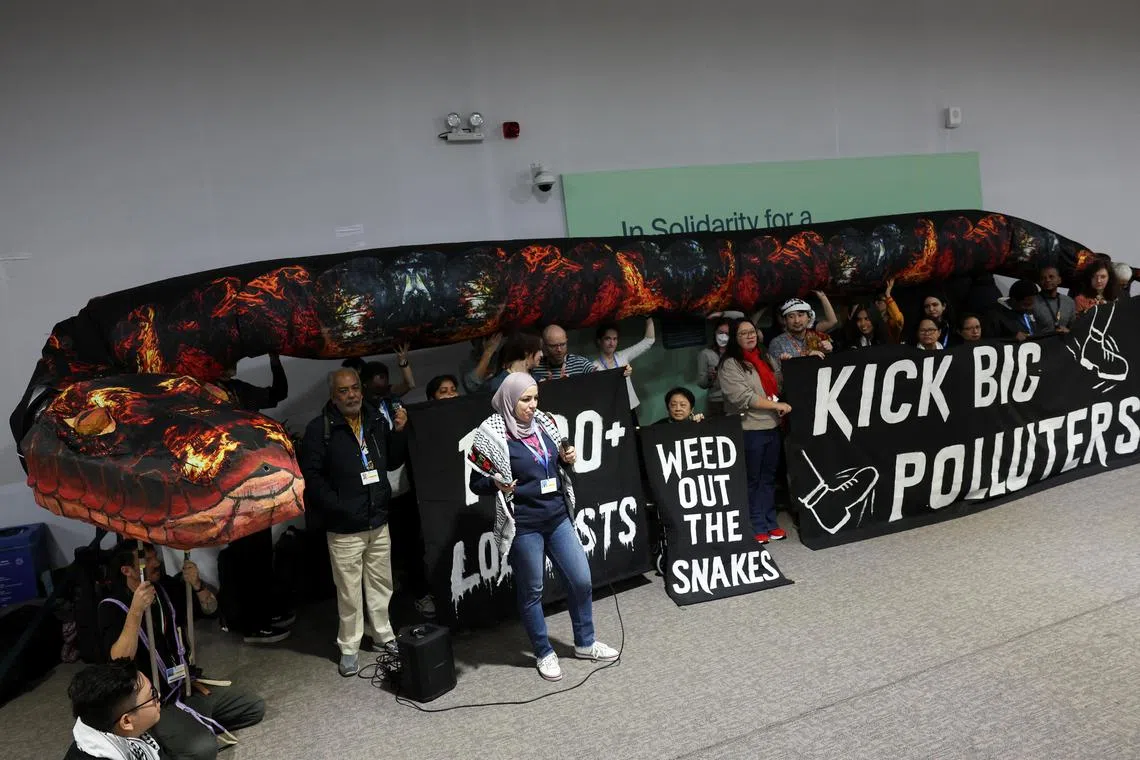
Environmental activists protesting against oil and gas lobbyists at COP29 in Baku, Azerbaijan, on Nov 15.
PHOTO: REUTERS
Follow topic:
BAKU - The more intense week two of the UN climate change conference (COP29) is under way, with world leaders and ministers arriving and leading the talks, in hopes of landing agreements that will push the climate agenda forward.
Tens of thousands of policymakers, activists and businesses have gathered inside white, windowless tents at the Baku Olympic Stadium in Azerbaijan.
The Straits Times reports on some highlights at the conference outside the rooms where heated negotiations are taking place.
1. Naming and shaming the ‘bad eggs’

The Climate Action Network-International representative holding up the Fossil of the Day trophy - a golden cup with a dinosaur head.
ST PHOTO: SHABANA BEGUM
An entertaining staple at COPs for decades now, the daily Fossil of the Day award is an ironic prize given to a country or a group of nations that have done the most to block progress in climate negotiations for the day.
The 15-minute award ceremonies – presented as a satirical skit and featuring a dinosaur mascot – are held in the evenings at any open space in the venue, pulling a crowd from young people to diplomats. It is organised by environmental network Climate Action Network-International (CAN).
On Nov 16, the Fossil of the Day cup was awarded to Italy, Europe’s second-largest gas importer that has pushed fossil fuel extraction in Africa for several decades. Italy also has a special relationship with COP29 host and petrostate Azerbaijan.
“The two countries trade fossil fuels like Pokemon cards,” said the CAN representative who handed the award – a golden trophy with a dinosaur head – to an Italian civil society organisation member playing along in the skit.
Azerbaijan exports 57 per cent of its oil to Italy. Azerbaijani gas imports to Italy also increased from 11 million cubic metres in 2020 to 10 billion cubic metres in 2023, according to think-tank Ecco Climate.
2. Expensive food
Inflated food prices in the foodcourts and booths at Baku Olympic Stadium are a key grouse of many COP delegates and participants, especially those from less developed countries.
A burger costs 25 Azerbaijani manat (S$20) and a plate of bolognese pasta is 41 manat. A cup of coffee is between 10 and 12 manat, which is more than double the price in Baku’s cafes.
African publication Nation reported that some African delegates are struggling to afford food at the COP29 venue.
A youth delegate from Africa, who asked to be anonymous, said she brought cereal from home to get through the long hours.
“But sometimes, I go hungry at the event. I go to the (country) pavilions that serve food but, some don’t give food if you’re not an event attendee,” she said.
CAN on Nov 16 said complaints of high prices led to a 10 per cent discount on some food items.
There were also reports of food items being mislabelled at the foodcourt, with salad containing beef and salmon labelled as “vegetarian”.
3. Muted protests
While climate protestors naturally want to be heard with megaphones and loud chants, many of them have had to resort to humming and snapping their fingers during demonstrations instead.
Activist groups said the UNFCCC – or the United Nations Framework Convention on Climate Change – which convenes COPs, have been increasingly strict about how protests are conducted. Others also cited authoritarian Azerbaijan’s limits on demonstrations.
Mr Muhammed Lamin Saidykhan from CAN said: “Around the plenary halls, we are only allowed to hum and snap our fingers to send our message out to leaders and delegates. There is no space for us to do a march and chant our slogans like we did in Egypt and Dubai... We were told it is because of logistics issues.”
Megaphones are only allowed in specific zones, far away from the negotiation rooms and delegate offices.
At the previous COPs in Egypt and Dubai in 2022 and 2023, protestors could stage demonstrations more freely within the conference venue, but they were not able to organise marches outside the venue or in the cities.
The last time a COP had a city-wide climate protest was in Glasgow in 2021, which saw 100,000 people taking to the streets.
On Nov 16, when climate protests happened across the world for the global “day of action” for climate justice, activists at COP29 could only wave flags, snap their fingers and hum forcefully. Some taped their mouths with the word “silenced” printed across.
4. Asean presence
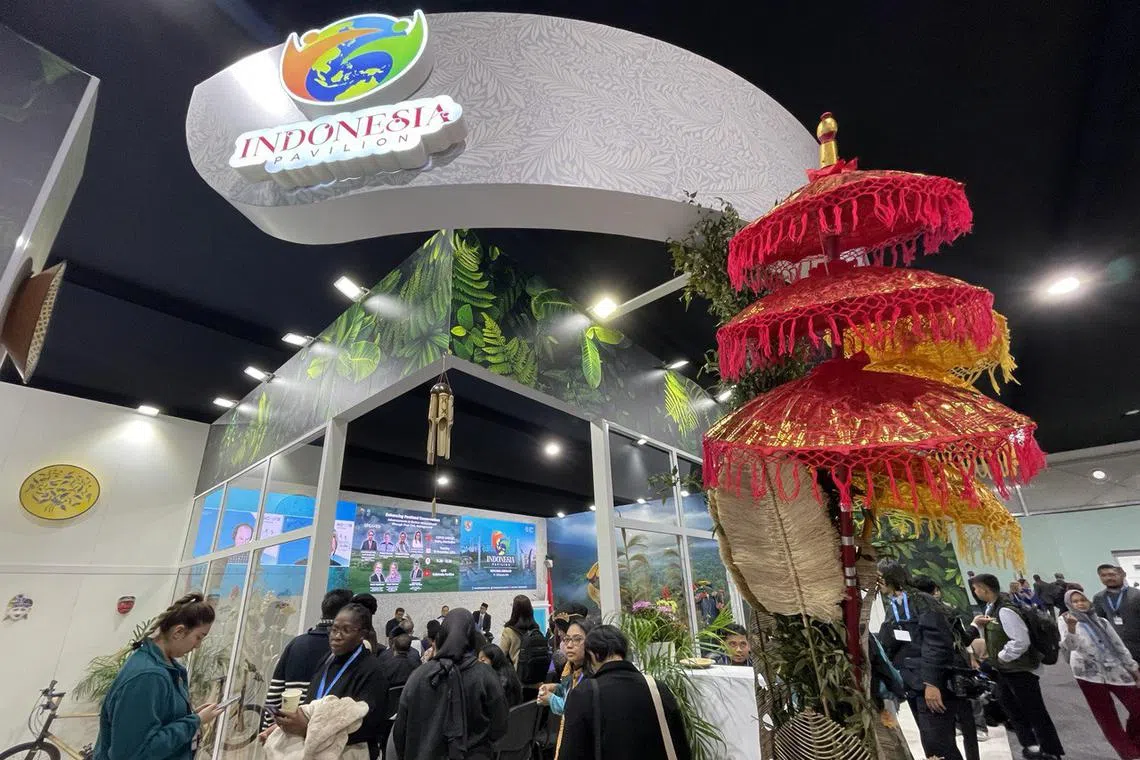
Indonesia’s pavilion at COP29. The South-east Asian nation sent 810 delegates to COP29.
ST PHOTO: SHABANA BEGUM
Within Asean, Indonesia appears to have sent the largest contingent to COP29, with 810 delegates.
Brunei has the leanest team, with six. Singapore sent more than 260 people, according to climate publication Carbon Brief.
The South-east Asian nations with country pavilions are Indonesia, Malaysia, the Philippines, Thailand and Singapore. Pavilions by countries or organisations – a dedicated space to host events and showcase local climate action – are among the more bustling places at the climate change summit.
These are areas where partnerships between countries are forged and knowledge is shared through networking.
While pavilions offer free food, coffee and merchandise to attract visitors, the Thailand pavilion has been milking its recent internet sensation – the baby pygmy hippopotamus Moo Deng.
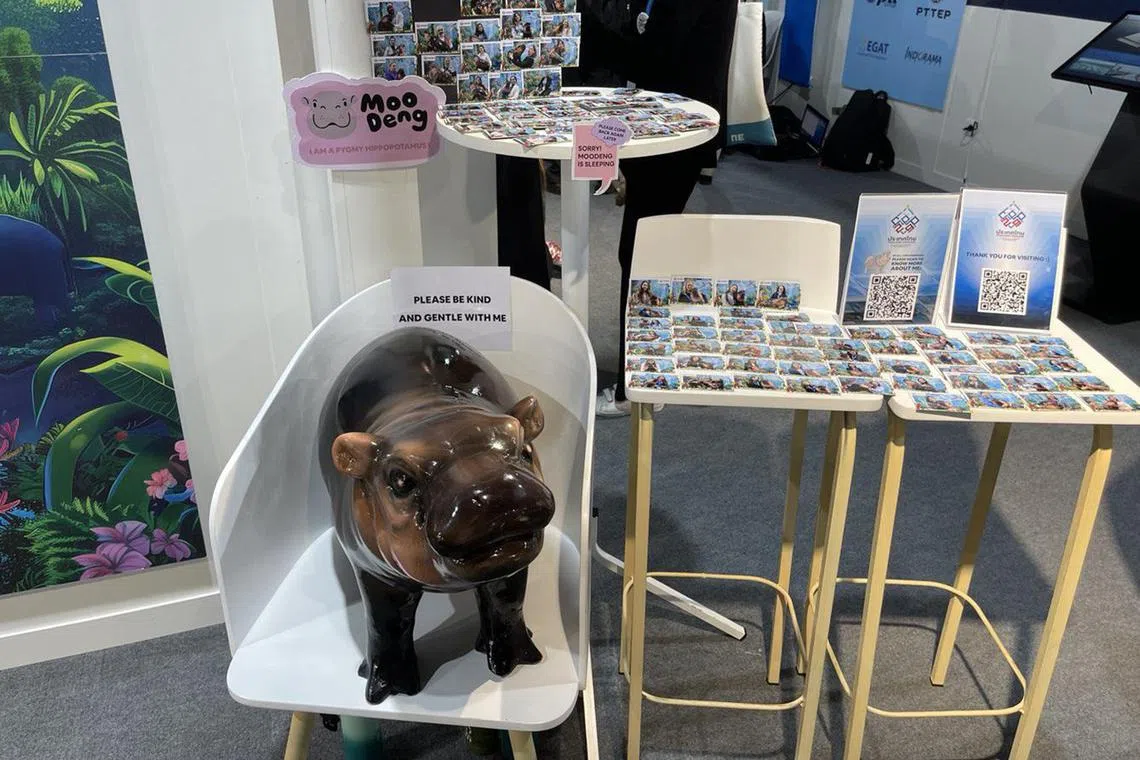
A Moo Deng doll that delegates can pose with, and their portraits pasted on a magnet (right).
ST PHOTO: SHABANA BEGUM
Weary delegates in need of some stress relief have been rushing to snap pictures with a Moo Deng doll. The pictures are then printed on a magnet.
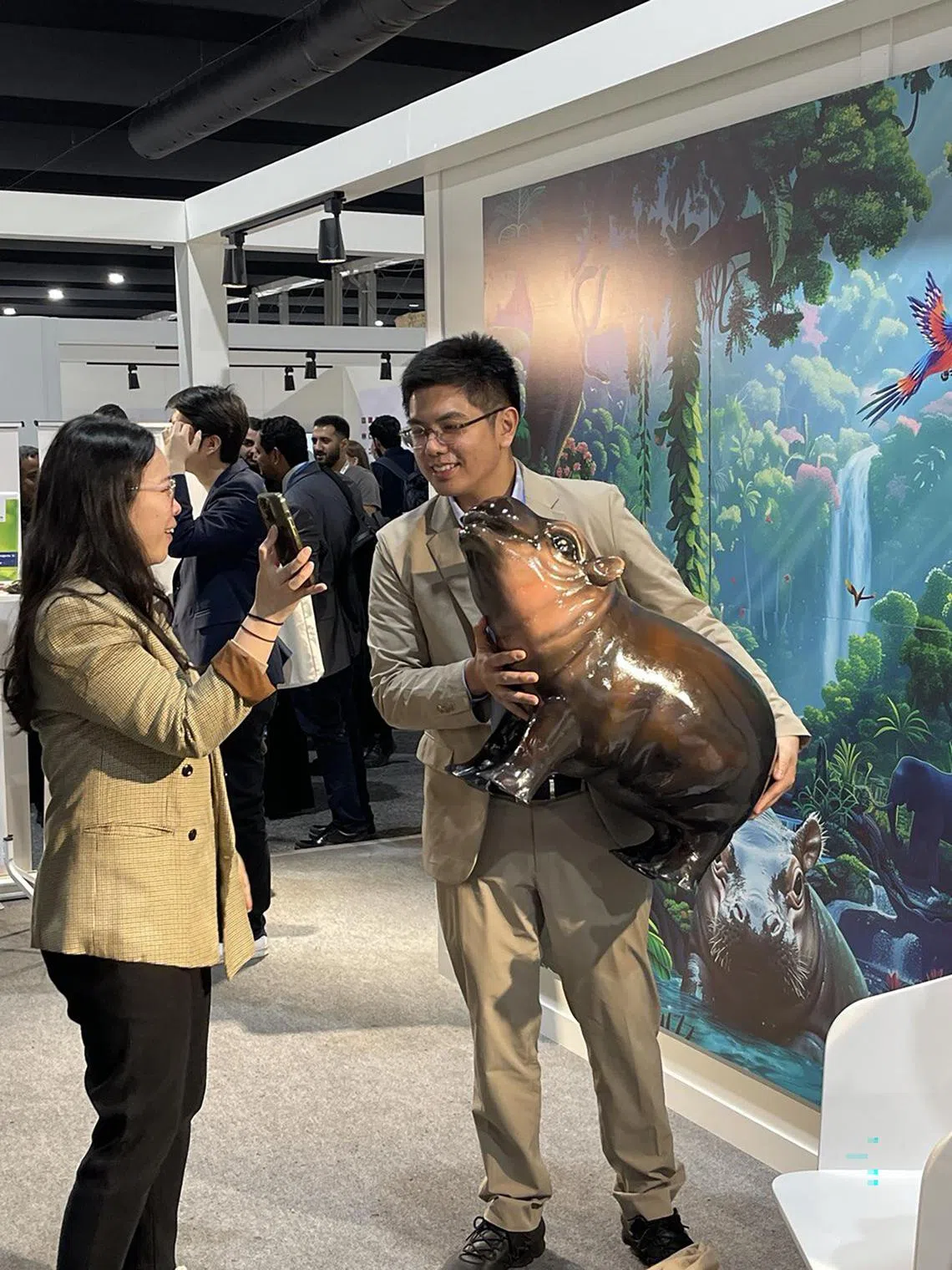
A delegate poses with the Moo Deng doll.
The Straits Times
Aside from this crowd-puller, Thailand’s pavilion also showcases its sustainability and adaptation strategies through information panels and digital displays. Since Thailand is a heatwave-prone country, the pavilion showcases a compact hot weather warning instrument with a heat index, laying out heat risks people should look out for as the mercury climbs.
5. Notable pavilions

Ukraine’s pavilion, which is made of recycled paper with plant seeds embedded in it. Visitors can also experience its sustainability plans through virtual reality.
ST PHOTO: SHABANA BEGUM
Despite being war-battered, Ukraine recently adopted a climate law outlining measures for achieving climate neutrality by 2050. In the country’s peace formula, addressing the extensive environmental damage caused by the war with Russia is one of its 10 priorities.
Most country pavilions are made of sturdy panels, concrete or wood. But the walls of the Ukraine pavilion are made of recycled paper, with plant seeds embedded in them, symbolising regrowth. The country’s green recovery plans and environmental initiatives are illustrated through a sprawling mural across the walls of paper.
Virtual reality goggles allow visitors to experience how a hydroelectric dam and reservoir that was blown up in 2023 and caused massive floods has now transformed into a forest of willows. After the attack on the dam, willow seeds settled on the dried up artificial reservoir, and now it is a 150,000ha willow forest.
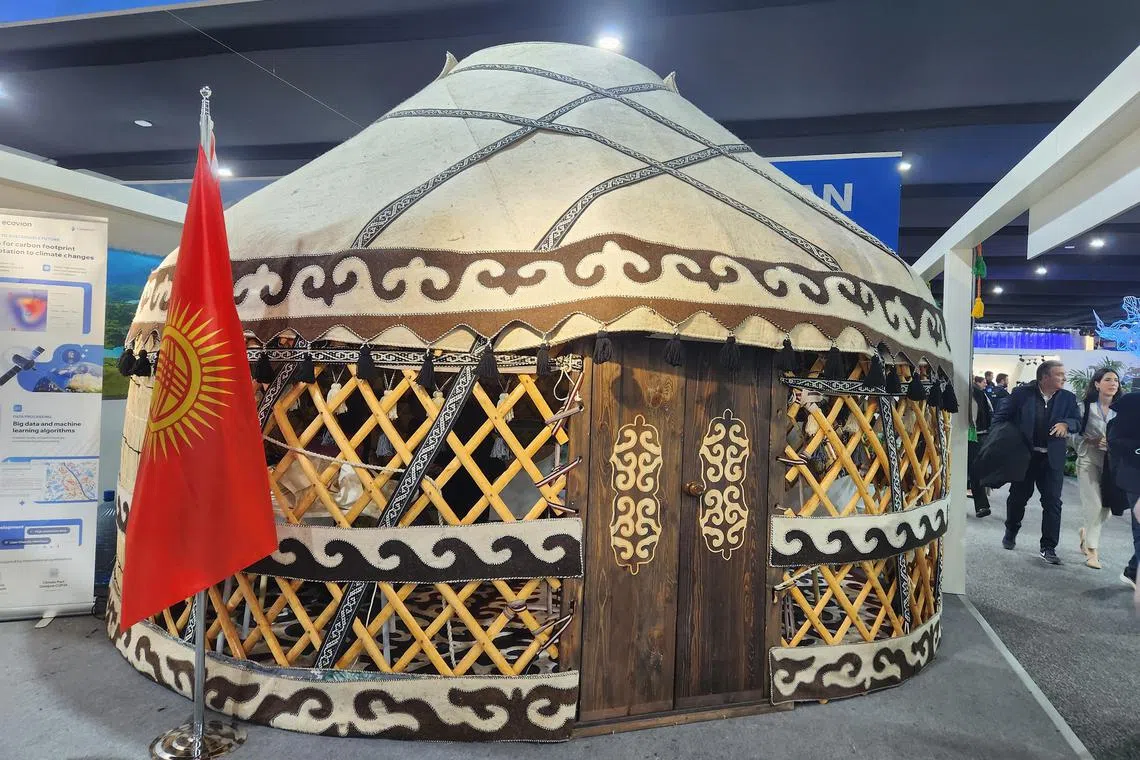
Visible from afar, Kyrgyzstan pavilion’s centre piece is a yurt, a traditional tent.
ST PHOTO: SHABANA BEGUM
China’s pavilion has rows of chairs made of weight-bearing cardboard. The Kyrgyzstan pavilion’s centrepiece is a yurt – a traditional central Asian tent made of felt and textiles. The cosy tent has been a conducive place for small meetings and interviews.


